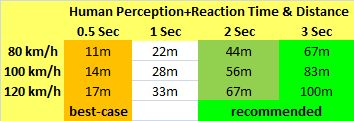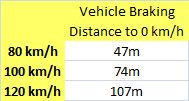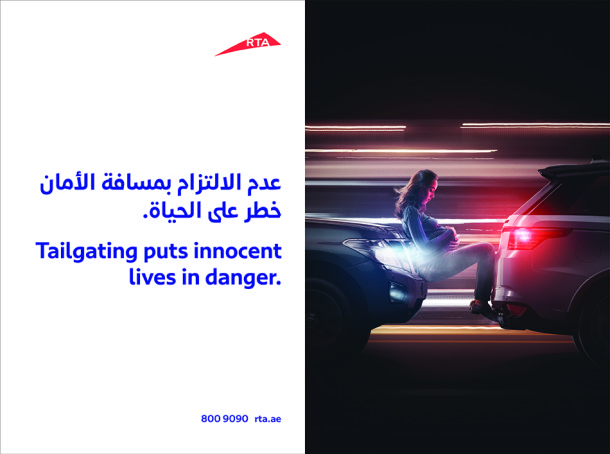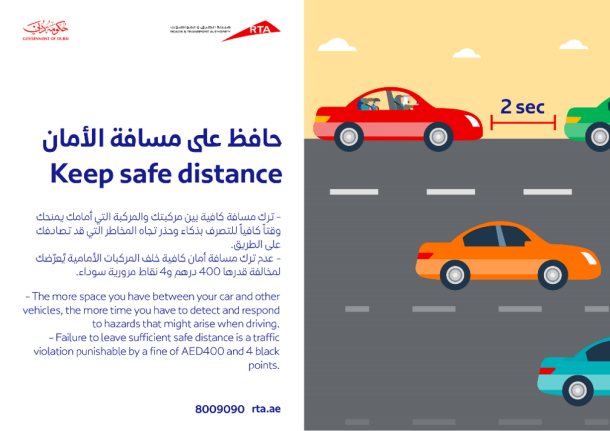
According to data from the Ministry of Interior (MOI), ‘not enough Distance to the car in front of you’ = Tailgating is the #3 killer on our roads – and this has been consistent for many years!
How to do it right!
We just need to keep a safe distance to the vehicle in front:
- To be able to slow down in time or even bring your vehicle to a stand-still, if needed
- To have a clear view of the traffic situation
- Use the “three-second rule” under normal road and weather conditions:
- when the vehicle ahead of you passes a certain point such as a sign, count “one-thousand-one, one-thousand-two, one-thousand-three.”
- Counting these numbers takes approximately three seconds. If you pass the same point before you finish counting, you are following too closely.
- In low visibility situations like in bad weather, increase this rule to the “five-second-rule“:
- consider this in sand/dust storms, fog or rain
- Use common sense and use the “five-second-rule’ in dangerous situations – this gives you time to react (think tire debris on highways!).
- Give plenty of space to motorcycles, as they are more vulnerable
- High-end cars often come with a distance warning system and even ‘adaptive cruise controls’ – consider this in your purchase decision and activate this functionality
Watch out for this
- Do not drive too close to the car in front of you.
- You endanger yourself and the car in front of you, and potentially the cars behind and around you.
- It is a sign of proper road etiquette and manners, not to bully the vehicle in front of you -show a ‘caring’ and respectful attitude
Important to know!
Many drivers, drive in a false belief that if the car in front suddenly started braking, they would react and brake and end up stopped the same distance apart.
The total stopping distance of a vehicle is made up of 4 components.
- A) Human Perception Time … time the brain reacts to danger
- B) Human Reaction Time … time the body reacts to brain commands
- C) Vehicle Reaction Time … determined by: break pedal free play, hydraulic properties
- D) Vehicle Braking Capability … depending on: tire pressure, weight, weather + street conditions
A) The human perception time; is how long the driver takes to see the hazard, and the brain realize it is a hazard requiring an immediate reaction. This perception time can be as long as ¼ to ½ a second.
B) Once the brain realizes danger, the human reaction time is how long the body takes to move the foot from accelerator to brake pedal. Again this reaction time can vary from ¼ – ¾ of a second.
A) and B) can be effected by tiredness/fatigue, concentration/distraction and alcohol levels. A perception and reaction time of 3 or 4 seconds is possible. Hence we are looking at the following safe distances:

C) + D) A car’s braking distance depends on its initial speed and the braking force generated. Braking distance increases quadratically with speed. For the examples above, the following distances have to be added to stop a vehicle to 0 km/h:

Remark: The braking force in this example is the minimum prescribed braking force of 5.2 m/s2. Under normal conditions, this braking force is around 8 m/s2. Sources: http://www.abs-bv.nl/en/home/467-double-the-speed-four-times-the-braking-distance; http://www.planetseed.com/mathsolution/braking-distances
Interesting articles:
- https://www.khaleejtimes.com/news/transport/everybody-hates-a-tailgater-in-uae-dont-be-one-
- https://gulfnews.com/uae/transport/revealed-why-drivers-tailgate-on-uae-roads-1.2116622
- http://gulfnews.com/news/uae/crime/dubai-radars-to-start-catching-tailgaters-from-july-1.1532297
- https://www.khaleejtimes.com/nation/dubai/-41-UAE-motorists-admit-to-tailgating-finds-study











question is what to do if somebody comes really close??? especially when you can’t change lanes like on a ramp.
I reduce my speed a little bit and many times guy behind me gets it.
but I am really not sure what is the safest way to react.
The first sentence in “How To Do it Right” is wrong : “To be able to break if needed” (sic) should be corrected to read to be able to BRAKE if needed.
The website of the Department of Motor Vehicles of California includes this helpful suggestion:
To avoid tailgating, use the “three-second rule”: when the vehicle ahead of you passes a certain point such as a sign, count “one-thousand-one, one-thousand-two, one-thousand-three.” Counting these numbers takes approximately three seconds. If you pass the same point before you finish counting, you are following too closely.
Hi Peter, thanks for your input! Apologies for the wrong spelling. We corrected this and added your contributions to the site. Drive safely!
RSU wants to share Diego’s comment as posted in our ‘proposals’ section:
http://www.roadsafetyuae.com/proposals/heavy-fines-drivers-keeping-safety-distance-tailgating/
Heavy fine should be imposed to tail gaiting. I think the speed radar technology can be also used to detect tail gating or cars not respecting safety distance. speed radars can detect the cars passing by a single point, so the interval between 2 cars can easily determine their distance and the car behind should be heavily fined.
Tail gating is extremely dangerous more than speeding. Slow cars on the left lane should not be a excuse for tailgating or flashing lights. In an ideal world, the left lane should be used only to overtake, but this is not the case in many parts of the world and UAE is not an exception, ultimately tailgating or lights flashing is not a solution for this and it is an instigation for an accident and this must be avoided.
I strongly agree with Diego’s comment. The safety measures on our roads, in particular on our highways, are massively biased towards drivers addressing exceeding the speed limit, which is not always dangerous.
Tailgating on the other hand is always dangerous, is endemic to our roads and is barely ever prosecuted. We hear more about prosecutions for disrespectful reactions to tailgating, than we do about prosecutions for drivers using tons of metal travelling at high speed to intimidate fellow road users and put their lives at risk.
It may be harder to detect than speeding (although as Diego points out, it may not) but focusing on a means to monitor and address tailgating would definitely have a marked effect on the safety of our highways.
Sometimes it is not possible to have three seconds rule. As you increase the gap, one more car will come in between and you again have to reduce your speed to accommodate it and so on.. In such case, it is advised to constantly watch 3-4 cars action infront of your car. As 3rd car infront of you start applying break, you also start breaking, without waiting for any action from car just in front of you. This way you can some what follow 3 second rule. This way you also can avoid collission from the car just behind you.
Tail Gating is a big issue and it endangers innocent drivers too… But the issue which i’m worried is that , when we follow the rules of 5 seconds or more , suddenly another car enters in that gap. Again we follow the 5 seconds rule. Another car enters in that gap. This means literally we will not move forward smoothly .Otherwise the whole road has to be monitored by video, like who does break the rule of the gap. Otherwise those people who are willing to follow the rule is likely to face the fines because of others fault.